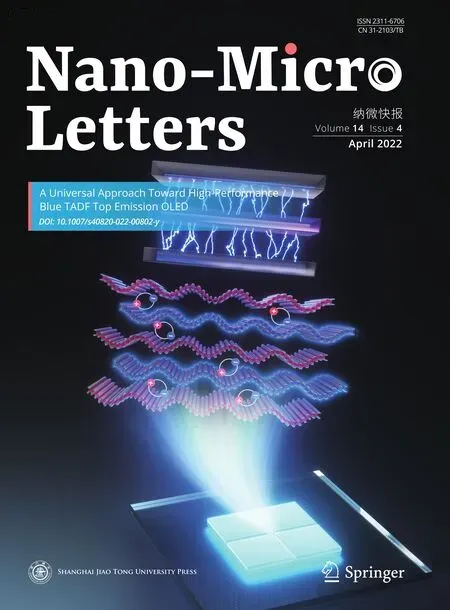Architecture Design and Interface Engineering of Self?assembly VS4/rGO Heterostructures for Ultrathin Absorbent
Qi Li,Xuan Zhao,Zheng Zhang,Xiaochen Xun,Bin Zhao,Liangxu Xu,Zhuo Kang,Qingliang Liao,Yue Zhang
ABSTRACT The employment of microwave absorbents is highly desirable to address the increasing threats of electromagnetic pollution.Importantly,developing ultrathin absorbent is acknowledged as a linchpin in the design of lightweight and flexible electronic devices,but there are remaining unprecedented challenges.Herein,the self-assembly VS4/rGO heterostructure is constructed to be engineered as ultrathin microwave absorbent through the strategies of architecture design and interface engineering.The microarchitecture and heterointerface of VS4/rGO heterostructure can be regulated by the generation of VS4 nanorods anchored on rGO,which can effectively modulate the impedance matching and attenuation constant.The maximum reflection loss of 2VS4/rGO40 heterostructure can reach -43.5 dB at 14 GHz with the impedance matching and attenuation constant approaching 0.98 and 187,respectively.The effective absorption bandwidth of 4.8 GHz can be achieved with an ultrathin thickness of 1.4 mm.The far-reaching comprehension of the heterointerface on microwave absorption performance is explicitly unveiled by experimental results and theoretical calculations.Microarchitecture and heterointerface synergistically inspire multi-dimensional advantages to enhance dipole polarization,interfacial polarization,and multiple reflections and scatterings of microwaves.Overall,the strategies of architecture design and interface engineering pave the way for achieving ultrathin and enhanced microwave absorption materials.
KEYWORDS Architecture design;Interface;Self-assembly;Microwave absorption
1 Introduction
With the advent of the 5G era,widespread applications of communication technologies and electronic devices have caused serious electromagnetic (EM) interference [1,2].The ever-increasing demands for the elimination of EM radiation hazards have spurred significant concerns to develop microwave absorption materials [3,4].Recently,amounts of traditional materials,such as ferrites [5],metallic magnets[6],and dielectric ceramics have been widely employed as microwave absorbents [7].However,the inherent defects such as larger thickness,high density,and narrow effective absorption bandwidth (EAB) seriously hinder their extensive applications,which is far from fulfilling the ultrathin and enhanced goals of microwave absorbent.Additionally,the boom of flexible and miniaturized smart electronic devices is eagerly demanding ultrathin and enhanced microwave absorbent [8].Thus,it is highly desired but remains a gigantic challenge to achieve high-performance microwave absorbent.
Currently,considerable attention has been focused on the design of high-performance microwave absorbents to tackle the issues of ultra-thick thickness,high density,and imperfect absorption intensity and bandwidth [9,10].Carbon nanostructures,including graphene [11],carbon nanotubes [12],fullerene [13],and so on,demonstrate great excellences to be designed as ultrathin and enhanced microwave absorbent because of their large specific surface area,remarkable thermal and electric conductivities,and exceptional dielectric properties [14].Reduced oxide graphene(rGO) as a widely studied two-dimensional (2D) material possesses residual oxygen-containing functional groups and defects that can be acted as attachment sites or dipole polarization centers [15-17].The pristine 2D rGO nanosheet has great potential to be designed as an ultrathin microwave absorbent but exhibits marginal microwave attenuation capability,which cannot bridge the gap of achieving enhanced microwave absorption.In order to cope with this issue,rGO microarchitectures with multiple winkles and microporous cavities are tailored and widely applied to promote microwave attenuation capability in virtue of the multiple reflections and scatterings of incident microwaves [18-20].The elaborate rGO microarchitecture fully maintains the superior privileges of rGO by evading excessive stacks or agglomerations,which can greatly contribute to pursuing the ultrathin microwave absorbent [21].For example,Pan et al.prepared hierarchical multi-dimensional carbon-based aerogels.The graphene layers were uniformly intercalated by three-dimensional (3D) helical carbon nanocoils,endowing the abundant microporous structure and better dielectric properties.The hierarchical multi-dimensional carbon-based aerogels showed the maximum reflection loss (RL) of -55.1 dB and EAB of 5.6 GHz [18].Gao et al.designed graphene microflowers with highly microporous architecture.The maximum RL and EAB of graphene microflowers were up to -42.9 dB and 5.59 GHz,respectively,showing significant increment compared with the stacked graphene,which is primarily due to the ascendancy microarchitecture [22].Dielectric losses,including dipole and interfacial polarization relaxations,are predominant in rGO microwave absorbent,whereas the pristine rGO possessing single dipole polarization relaxation is difficult to obtain multiple dielectric losses.Therefore,introducing a heterointerface to stimulate interfacial polarization relaxation of rGO-based absorbent is another smooth road to enhance microwave absorption performance.For instance,Ji et al.anchored metal oxide granular film on graphene with large surface area and high charge carrier concentrations to construct heterointerface.The prepared graphene/metal oxide exhibited the EAB of 7.0 GHz with a thickness of 2 mm because of the strong interfacial polarization relaxation [23].He et al.successfully developed rGO/MoS2nanosheets heterostructure.The prepared rGO/MoS2nanosheets heterostructure possessing multiple conductive networks and heterointerfaces demonstrated the EAB of 5.7 GHz and maximum RL of -60 dB with a thickness of 2.5 mm [24].Thence,the inspired interfacial polarization relaxation usually can endow rGO-based absorbent with enhanced microwave attenuation capability. VS4with a narrow bandgap of ≈1.0 eV stands out from the transition metal sulfides due to its Peierls distortions,good dielectric characteristics,and environmental benignities.Moreover,the unique chain-like VS4nanostructure formed by van der Waals force is easy to anchor on rGO to generate heterointerface (Fig.S1) [25].Accordingly,motivated by the unparalleled merits of rGO microarchitecture and VS4nanostructure,the synergy of microarchitecture and heterointerface may provide exceptional feasibilities to achieve enhanced VS4/rGO microwave absorption materials.
Herein,architecture design and interface engineering strategies are implemented to prepare self-assembly VS4/rGO heterostructure as ultrathin microwave absorbent. VS4nanorods are tightly and evenly anchored on rGO,generating abundant microarchitectures and rich heterointerfaces.The synergy of microarchitecture and heterointerface effectively modulates the impedance matching and attenuation constant of VS4/rGO heterostructure,thus achieving the ultrathin absorbent with enhanced microwave absorption performance.The maximum RL of 2VS4/rGO40 heterostructure can reach as strong as -43.5 dB at 14 GHz and 1.5 mm with the impedance matching and attenuation constant approaching 0.98 and 187,respectively.Furthermore,the EAB of 4.8 GHz can be achieved with an ultrathin thickness of 1.4 mm.More importantly,architecture design and interface engineering significantly contribute to motivating the multi-dimensional advantages of VS4/rGO heterostructure.(i) The anisotropic one-dimensional (1D) VS4nanorods with high aspect ratio greatly facilitate dipole and interfacial polarization relaxations.(ii) 2D rGO nanosheets with VS4nanorods attached can effectively modulate the impedance matching and boost interfacial polarization.(iii) 3D reticulum-like microporous architecture of VS4/rGO heterostructure induces multiple reflections and scatterings of incident microwaves.Moreover,combining with density functional theory calculation,the effects of VS4/rGO heterointerface for polarization relaxation are also further investigated,inducing reinforcement in microwave absorption performance.Overall,the synergy of architecture design and interface engineering for the construction of self-assembly VS4/rGO heterostructure can extend the development of ultrathin microwave absorbent.
2 Experimental Section
2.1 Synthesis of rGO Microarchitecture
Graphene oxide (GO) was prepared by the modified Hummers method from graphite powder.rGO architecture was synthesized by facile hydrothermal and freeze-dying methods.Typically,80 mg of GO powder was uniformly dispersed in 60 mL deionized water by sonication of 90 min.Then,the prepared uniformly homogeneous GO dispersion was transferred into a Teflon-lined stainless autoclave and heated to 180 °C for 10 h.After cooling to room temperature and freezing in the refrigerator at -20 °C,the frozen hydrogel was put into a vacuum freeze dryer to remove ice and acquire rGO architecture.
2.2 Synthesis of VS4/rGO Heterostructure
Typically,the VS4/rGO heterostructures were successfully performed by a facile one-step hydrothermal method.Initially,5 mmol of Na3VO4and 25 mmol of CH3CSNH2were put into 60 mL dispersion containing 40 mg of GO under constant magnetic stirring until formed a homogeneous solution at 60 °C.Then,the mixed solution was transferred into 100 mL of Teflon-lined stainless autoclave and heated to 160 °C for 24 h.After cooling to room temperature,the product was collected and washed with deionized water three times and placed in the refrigerator at -20 °C for 12 h.Subsequently,the frozen product was performed to remove the water of VS4/rGO heterostructures via a freeze-drying method.As Table S1 shows,the VS4/rGO heterostructures with different content of VS4nanorods and rGO marked as 1 VS4/rGO40,3VS4/rGO40,2VS4/rGO20,and 2VS4/rGO60 were prepared by the same method.
2.3 Synthesis of VS4/rGO Nanocomposite
VS4nanorods were prepared via a hydrothermal method.In a typical process,5 mmol of N a3VO4and 25 mmol of CH3CSNH2were dissolved in 60 mL of deionized water to obtain the mixed solution,and then 1 mol L-1NaOH aqueous solution was added to manipulate the pH of 12.After magnetic stirring of 0.5 h at 60 °C,the solution was transferred into 100 mL of Teflon-lined stainless autoclave and heated to 160 °C for 24 h.After cooling to room temperature,the product was collected and washed with deionized water three times.Then,the purified product was dried in a vacuum oven at 60 °C for 12 h to obtain the pristine VS4nanorods.
VS4/rGO nanocomposite was prepared by the ultrasonic dispersion method.Detailly,the VS4nanorods and rGO were dispersed into the absolute ethanol under ultrasound condition,and the molar ratio of VS4nanorods and rGO was about 3:1.Then,the prepared VS4/rGO nanocomposite was obtained by centrifugal separation and vacuum drying method.
2.4 Characterization and EM Parameters Measurement
The morphology and microstructure of the prepared VS4/rGO heterostructures were characterized by field emission scanning electron microscope (FESEM;FEI,Quanta3D FEG) and transmission electron microscope (TEM;TECNI G2 F20).The crystal structures were measured by X-ray diffraction (XRD;Rigaku DMAX-RB).Raman spectra were obtained by Jobin-Yvon Raman microprobe (JYHR800) under 532 nm laser excitation.Chemical compositions and valence states were analyzed by X-ray photoelectron spectrometer (XPS;Thermo Fisher ESCALab250).Thermo-gravimetric analysis (TGA) was conducted in dry air by using a TA Q-600.The nitrogen adsorption/desorption experiments were performed in Micromeritics ASAP2020.The specific surface area was obtained by using Brunauer-Emmett-Teller (BET) analysis.Pore size distributions were assessed by using the Barrett-Joyner-Halenda(BJH) method.
The EM parameters,including permittivity and permeability,were measured by a vector network analyzer system(HP722ES) in the frequency range of 2-18 GHz.The VS4/rGO heterostructures were uniformly dispersed in paraffin with filler loadings of 20%,30%,and 40%.Then,the asprepared mixture was pressed into a toroidal-shaped specimen with an inner diameter of 3.04 mm,an outer diameter of 7.0 mm,and a thickness of 2.0 mm.The EM parameter measurements of V S4nanorods,rGO architecture,and VS4/rGO nanocomposite were like VS4/rGO heterostructure.The complex permittivity and permeability of the as-prepared samples were further to be measured.
2.5 DFT Calculation
The Vienna Ab-initio Simulation Package (VASP) software was used to simulate computation based on density functional theory (DFT).The interaction between ions and electrons was described by the projector-augmented wave(PAW) method.The Generalized Gradient Approximation(GGA) with the Perdew Burke Ernzerhof (PBE) function was employed as the exchange associated functions.
3 Results and Discussion
Figure 1a schematically illustrates the synthetic process of self-assembly VS4/rGO heterostructure.The VS4/rGO heterostructure with abundant microarchitectures and rich heterointerfaces was fabricated through hydrothermal and freezedying methods.Similarly,the pristine VS4nanorods were fabricated without rGO by the same hydrothermal reaction.Meanwhile,Fig.1 also shows a series of SEM and TEM images of the VS4nanorods and self-assembly VS4/rGO heterostructure.Figure 1b reveals that the VS4nanorods are seriously agglomerated due to the absence of a growing template.In Fig.1c,the rGO architecture demonstrates reticulum-like microarchitecture with lots of randomly distributed nano-walls formed by wrinkled nanosheets.Figures 1d and S2 exhibit that the self-assembly VS4/rGO heterostructure also possesses numerous wrinkles and microporous architecture originated from scrolling and folding of rGO.The crooked VS4nanorods are evenly anchored on the surface of rGO as Fig.1e elucidated.Furthermore,the heterointerfaces between VS4nanorods and rGO are clearly shown in Fig.1f,and the average lateral and longitudinal sizes of VS4nanorods are about 20-40 and 100-300 nm,respectively.High-resolution transmission electron microscopy(HRTEM) image of VS4/rGO heterostructure with distinct lattice is exhibited in Fig.1g.The interlayer spacings of 0.56 nm and 0.37 nm correspond to (1 1 0) plane of V S4and (0 0 2) plane of rGO,respectively [25].Therefore,the interface between VS4and rGO can be clearly observed,but the distinct voids and gaps at boundaries do not appear,exhibiting the tight combination of VS4nanorods and rGO.
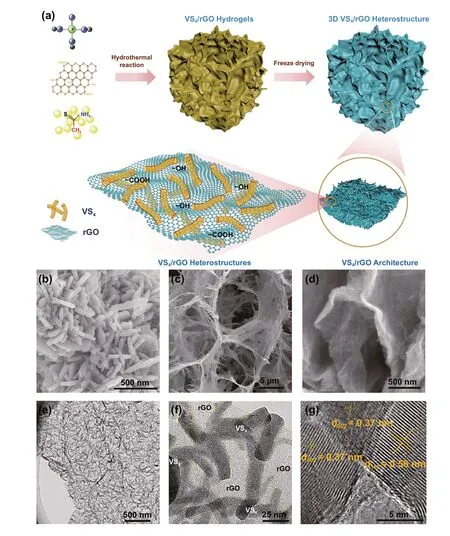
Fig.1 a Schematic illustration of the synthesis processes for self-assembly VS4/rGO heterostructure.SEM image of b VS4 nanorods,c rGO architecture,and d VS4/rGO heterostructure.e,f TEM images of VS4/rGO heterostructure with different magnification.g HRTEM images of VS4 nanorods showing the d-spacing of 0.56 nm in the (110) plane and rGO showing the d-spacing of 0.37 nm in (0 0 2) plane
The elemental compositions of VS4/rGO heterostructure are further measured by energy dispersive spectroscopy(EDS).Figure 2a presents the VS4nanorods are horizontally and evenly aligned on the rGO.Figure 2b shows that the elements of V,S,C,and O can be identified from the survey scan of EDS with the atomic proportions of 10.27,42.66,41.36,and 5.71 at%,respectively.The stoichiometric ratio of V and S atoms is around 1:4,which proves the existence of VS4[25].Further confirmed by the elemental mapping of Fig.2c,the four elements of V,S,C,and O are detected on the surface of VS4/rGO heterostructure.The C element is derived from rGO,and the O element mainly originates from the residual oxygen-containing functional groups of rGO [26,27].The crystalline phase of the prepared VS4/rGO heterostructure is revealed by X-ray diffraction (XRD).Figure 2d shows the two major peaks of 15.8° and 17.0° are assigned to the (1 1 0) and (0 2 0) planes of monoclinic VS4(JCPDS No.072-1294) [28].Figure 2e demonstrates the Raman spectra of V S4nanorods,rGO,and VS4/rGO heterostructure.The peaks located at 191.6 and 280 cm-1are attributed to the stretching (A1) and bending (B1) modes of V-S chemical bands,respectively.The characteristic peaks located at 1342 and 1593 cm-1correspond to the D and G peaks of rGO.In addition,the peak intensity ratio of D and G for VS4/rGO heterostructure (1.1) is higher than rGO(0.96),revealing the formation of plentiful defects and distortions caused by structural imperfection and heterointerface [29].
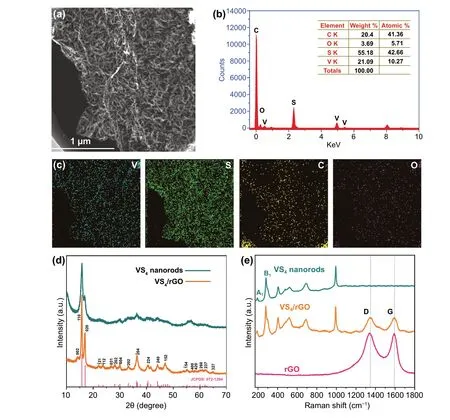
Fig.2 a TEM image of VS4/rGO heterostructure for the EDS mapping.b EDS spectra and the table of elemental composition.c TEM image corresponding to EDS elemental mappings:V,S,C and O.d XRD patterns of VS4 nanorods and VS4/rGO heterostructures.e Raman spectra of VS4 nanorods,rGO and VS4/rGO heterostructure
The surface chemical state of VS4/rGO heterostructure is investigated by X-ray photoelectron spectroscopy (XPS)(Fig.S3).Figure 3a shows the high-resolution XPS spectrum of V 2p.The characteristic peaks of 516.5 and 524 eV are attributed to V 2 p3/2and V 2p1/2,corresponding to the V4+of VS4[30,31].The other two characteristic peaks of 513.9 and 521.8 eV derived from V-C chemical bonds can be clearly detected,confirming the strong bonding and abundant heterointerface between VS4and rGO [32].In contrast,the high-resolution XPS spectra of VS4nanorods and VS4/rGO nanocomposite prepared by ultrasonic dispersion method are shown in Figs.S4 and S5,respectively.As shown in Fig.S5a,the high-resolution spectrum of V 2p lacks the V-C band peak,which is due to V S4nanorods fail to be fabricated and anchored on rGO.Figure S5b-c exhibits that the high-resolution spectra of S 2pand C 1sare the same as the VS4/rGO heterostructure.Compared with VS4nanorods and VS4/rGO nanocomposite,the V 2p3/2of VS4/rGO heterostructure demonstrates a positive shift,indicating the electrons transfer from VS4nanorods to rGO (Fig.S6).As Fig.3b shown,the corresponding peaks located at 162.7 and 163.8 eV originating from the S22-ions can be indexed to S 2p3/2and S 2p1/2,respectively [32].Figure 3c shows the fitted C 1speaks approximately locate at 284.7,285.7,286.7,and 288.6 eV,respectively.These C 1speaks are originated in the presences of C-C/C=C in the aromatic ring and the residual oxygen-containing functional groups such as -OH and -COOH [33].

Fig.3 XPS spectra of VS4/rGO heterostructures:a V 2p,b S 2p,c C 1s.d TGA curves of VS4/rGO heterostructures.e Nitrogen adsorptiondesorption isotherms.f Different BET surface areas of VS4/rGO heterostructures
The VS4/rGO heterostructures are analyzed by thermogravimetric analysis (TGA) to evaluate their thermal stability and content.As Fig.3d shows,the small weight loss of VS4/rGO heterostructures below 200 °C is attributed to the desorption of moisture.The large weight losses over 200-250 and 250-350 °C are related to the decomposition of VS4nanorods and the oxidation reaction of sulfur compounds,respectively.The oxidation decomposition of rGO is observed at 370-500 °C.After 600 °C,the slight weight gain is caused by the further oxidation of vanadium oxide [33,34].The N2adsorption-desorption isotherm is obtained to measure the surface area and pore size distribution of VS4/rGO heterostructure.Figure 3e shows that the isotherms of VS4/rGO heterostructures exhibit type-IV curve accompanied by weak hysteresis loop,thus implying the presence of numerous mesopores.In order to evaluate the microarchitecture and heterointerface of self-assembly VS4/rGO heterostructure,BET surface area and TGA result are combined to clarify their relationships.Firstly,the amount of GO (40 mg) remains unchanged to regulate the preparation of VS4nanorods and modulate the VS4/rGO heterointerface.Generally,the VS4/rGO heterostructure with the higher content of VS4nanorods causes the larger VS4/rGO heterointerface formed by the attachment of VS4on rGO.The BET surface area usually can indicate the abundance of microarchitecture.The contents of VS4nanorods for 1VS4/rGO40,2VS4/rGO40,and 3VS4/rGO40 calculated by TGA results are about 17.75,32.69,and 38.53 wt%,respectively.Correspondingly,the BET surface areas of 1VS4/rGO40,2VS4/rGO40,and 3VS4/rGO40 measured by nitrogen adsorption-desorption isotherms can reach 78.95,88.95,and 40.82 m2g-1,respectively.2 VS4/rGO40 with the optimal 32.69 wt% of V S4nanorods possesses the largest BET surface area of 88.78 m2g-1,manifesting abundant microarchitectures and rich heterointerfaces.However,rGO cannot provide enough attachment sites for the excessive generation of VS4nanorods,causing the serious agglomeration of VS4nanorods.Agglomerated VS4nanorods will wreck the inherent microarchitecture and further shrink the BET surface area.Wherefore,3VS4/rGO40 with the highest 38.53 wt% of VS4nanorods possesses the smallest BET surface area of 40.82 m2g-1,leading to insufficient microarchitectures. 1VS4/rGO40 with the lowest 17.75 wt% of VS4nanorods usually generates the minimal heterointerface but higher BET surface area derived from rGO.The BET surface area of 1VS4/rGO40 is smaller than 2VS4/rGO40,which is mainly due to the shortage of the support of V S4nanorods.Secondly,the content of the prepared VS4nanorods remains unchanged within a certain range to regulate the amount of GO.The contents of VS4nanorods for 2VS4/rGO20 and 2VS4/rGO60 are up to 31.36 and 39.01 wt%,respectively.Correspondingly,the BET surface areas of 2VS4/rGO20 and 2VS4/rGO60 can reach 54.38 and 65.77 m2g-1,respectively.Figure 3f clearly displays the differences on BET surface area of the fabricated VS4/rGO heterostructures.Generally,the optimized amount of GO can provide a suitable surface and active sites to anchor VS4nanorods.On the contrary,the excessive amount of GO cannot make the specific content of VS4nanorods evenly attach to its surface.The prepared VS4nanorods are not connected to each other and cannot provide strong skeleton support for rGO microarchitecture.Therefore,the local collapse of the microarchitecture of 2VS4/rGO60 hinders the achievement of the largest BET surface area. 2VS4/rGO20 demonstrates a smaller BET surface area of 54.38 m2g-1than 2VS4/rGO40,which is mainly due to the less content of GO.
In general,combined with TGA results of VS4/rGO heterostructure,BET surface area can accurately reveal the relationship of microarchitecture and heterointerface.The pore size distributions of VS4/rGO heterostructures are calculated by Barrett-Joyner-Halenda (BJH) method.The pore size distributions of reticulum-like microporous V S4/rGO heterostructures are shown in Fig.S7.The mesopores and macropores existing in the VS4/rGO heterostructure are associated with the content of GO in the hydrothermal reaction process.Additionally,2VS4/rGO40 with the largest heterointerface area demonstrates more reticulum-like micropores that provide plentiful microporous networks [32-34].
To evaluate the microwave absorption performance,the EM parameters,including complex permittivity (εr=ε′-jε") and complex permeability (μr=μ′-jμ″),are measured by vector network analyzer system (HP722ES) in the frequency range of 2-18 GHz.According to the EM energy conversion principle,the real parts of complex permittivity (ε′) and permeability (μ′)are associated with electrical and magnetic energy storages,respectively.However,the imaginary parts of permittivity (ε″)and permeability (μ″) represent the dissipations of electric and magnetic energies,respectively [35].As shown in Fig.4a,theε′of VS4/rGO heterostructures with the different filler loadings exhibit a downward tendency in the frequency range of 2-18 GHz.When the frequency of the microwave is increasing,the dipoles existing in VS4/rGO heterostructure cannot reorient themselves quickly enough to respond to the applied alternating EM feild.Therefore,the complex permittivity starts to decrease and generates typical frequency dispersion behaviors.
When the filler loadings of 2VS4/rGO20,2VS4/rGO40,and 2VS4/rGO60 are fixed at 30 wt%,theε′of 2VS4/rGO40-30% demonstrates a decreasing tendency from 16.91 to 12.0,and the values ofε′for 2VS4/rGO20-30%and 2VS4/rGO60-30% all display decreased trends.Theε′value of 2VS4/rGO60-40% is higher than 2VS4/rGO60-30%,which is mainly due to the increase of dielectric media.The values ofε′for 1VS4/rGO40 and 3VS4/rGO40 maintain a relatively lower level.Figure 4b demonstrates the changing trend ofε″is different fromε′.In general,the values ofε″increase with the filler loading of VS4/rGO heterostructures,which is related to the presence of abundant microarchitectures and heterointerfaces.Based on the analysis of TGA results and BET surface area,2VS4/rGO40 possesses abundant microarchitectures and rich heterointerfaces,demonstrating the highest ε″ than other samples with the filler loading of 30 wt%.Theε″of 2VS4/rGO40 is over 3.0 in the frequency range of 2-18 GHz,indicating the great EM energy attenuation ability.The other samples exhibit lower values ofε″,which are mainly due to the poor microarchitecture and insufficient heterointerface.Additionally,the multiple dielectric relaxation peaks exhibiting in theε″-fcurves are derived from nonlinear resonant behaviors of VS4/rGO heterointerfaces [36,37].Correspondingly,2VS4/rGO40 demonstrates obvious and corrugated resonance peaks in theε″-fcurves of 7-11 GHz and 13-16 GHz,further manifesting the promotion of abundant microarchitectures and rich heterointerfaces for dielectric loss.
In order to evaluate the dielectric loss capability,the values of tanδε(tanδε=ε″/ε′) are shown in Fig.4c.The curves of tanδεdisplay several fluctuations in the frequency range of 8-18 GHz,which are mainly due to the orientations of induced dipoles.Additionally,the dipole moments cannot match up with the alternating EM fields in high-frequency range.Furthermore,the weak magnetic properties of VS4/rGO heterostructure cause the values ofμ′andμ″to fluctuate around 1 and 0,respectively.Therefore,the calculated tanδμ(tanδμ=μ″/μ′) of VS4/rGO heterostructure is closed to 0 (Fig.S8).According to Debye relaxation theory,theεrcan be indicated as Eq.1 [38]:
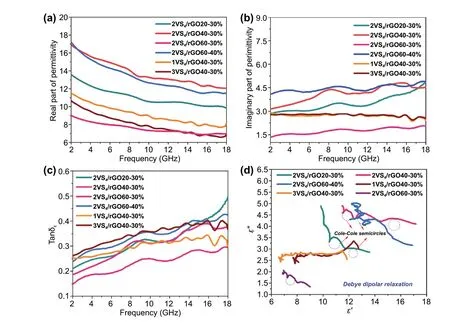
Fig.4 Permittivity and dielectric loss tangent of VS4/rGO heterostructures in the frequency range of 2-18 GHz:a ε′,b ε",c Tan δε.d Cole-Cole semicircles for VS4/rGO heterostructure

wherefrepresents the frequency,τis the polarization relaxation time,εrandε∞r(nóng)epresent the stationary permittivity and the optical dielectric constant,respectively.Meanwhile,theε′andε″can be further demonstrated as Eqs.2 and 3:

Based on the aforementioned Eqs.1-3,the relationship betweenε′andε″can be clearly expressed as Eq.4:

According to Eq.4,the curve ofε′versusε″e(cuò)xhibits a single semicircle denoted as Cole-Cole semicircle,which illustrates the process of Debye dipolar relaxation.Generally,the dielectric loss also can be obviously represented by Debye dipolar relaxation [39].The curves ofε′versusε″for VS4/rGO heterostructures are shown in Fig.4d,in which the presence of semicircles demonstrates the multiple dielectric relaxation losses.
In order to evaluate the microwave absorption performance,the RL of VS4/rGO heterostructure usually can be calculated by the measured complex permittivity and permeability.The RL can be evaluated by Eqs.5 and 6 based on the transmission line theory [40]:

Z0andZinrepresent the characteristic impedance of free space and the input impedance of absorbent,respectively.fis the frequency of the incident microwave;tis the thickness of the absorbent layer;cis the velocity of light.To reveal the influence of the frequency and thickness of absorbent,Fig.5 outlines the RL curves and 3D presentations of the calculated RL of VS4/rGO heterostructures within the thickness of 1-6 mm and in the frequency range of 2-18 GHz.
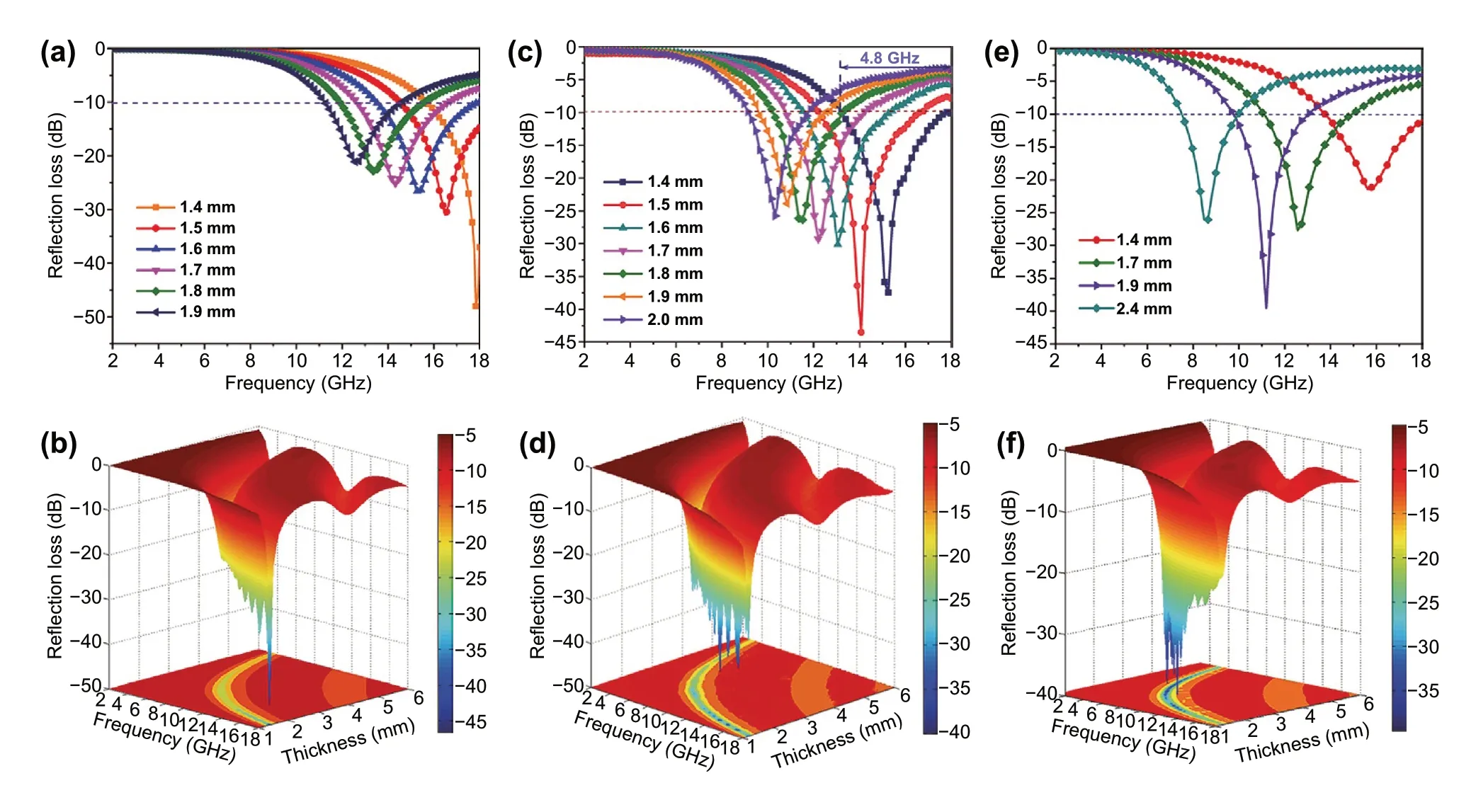
Fig.5 RL curves and 3D presentations of VS4/rGO heterostructures at the thicknesses of 1 to 6 mm in the frequency range of 2-18 GHz:a,b 2VS4/rGO20-30%;c,d 2VS4/rGO40-30%;e,f 2VS4/rGO60-40%
The microwave absorption performance of VS4/rGO heterostructure can be modulated by manipulating the thickness and filler loading.The effective microwave absorption performance means that 90% of incident microwaves are attenuated,corresponding to the value of RL exceeding -10 dB.Figure 5a-b illustrates that the maximum RL of -48.4 dB for 2VS4/rGO20-30% can be achieved at 17.8 GHz with a thickness of 1.4 mm.Figure 5c-d shows that the EAB of 2VS4/rGO40-30% is up to 4.8 GHz (13.2-18 GHz) with a thickness of 1.4 mm,and the maximum RL can reach as strong as -37.4 dB.Under the same thickness,the EAB of 4.8 GHz for VS4/rGO heterostructure is larger than that of other graphene-based microwave absorbents.Therefore,the VS4/rGO heterostructure has great potential in the design of ultrathin absorbents.The microwave absorption performances of 1VS4/rGO40-30% and 3VS4/rGO40-30% are shown in Fig.S9.The maximum RLs of 1VS4/rGO40-30%and 3VS4/rGO40-30% all reach -25 dB,and their EABs are very narrow with a thickness of 1.4 mm.Figure 5e-f demonstrates that the EAB of 2VS4/rGO60-40% can reach as strong as 4.25 GHz with a thickness of 1.4 mm,and its maximum RL is up to -39.5 dB at 11.2 GHz with a thickness of 1.9 mm.The microwave absorption performances of other VS4/rGO heterostructures with different filler loadings are demonstrated in Figs.S10 and S11.
Figure 6 a demonstrates the 3D RL presentations of rGO,VS4nanorods,VS4/rGO nanocomposite,and VS4/rGO heterostructure (2VS4/rGO40-30%).Specifically,the maximum RLs of rGO architecture and VS4nanorods are about-7.5 and -3.2 dB with a thickness of 1.5 mm,respectively.However,the maximum RL of 2VS4/rGO40-30% is up to -43.5 dB at 14 GHz with a thickness of 1.5 mm,overwhelmingly outperforming the microwave absorption performances of rGO architecture and V S4nanorods.In contrast,the VS4/rGO nanocomposite prepared by the ultrasonic dispersion method shows the weak RL of -6.9 dB with a thickness of 1.5 mm (Fig.S11a).The self-assembly VS4/rGO heterostructure holds the intimate contact heterointerface that is proved by the previous characterizations of TEM and XPS.However,the pristine VS4nanorods and rGO architecture are short of heterointerfaces,and the absence of interfacial polarization relaxation fails to promote microwave attenuation.So,it can be concluded that the VS4/rGO heterointerface benefits the enhancement of microwave absorption performance.Compared with the VS4/rGO nanocomposite,the VS4/rGO heterostructure with rich microporous architectures can greatly improve the multiple reflections and scatterings of microwaves,which exponentially boost microwave attenuation.Theε′,ε″,and tanδεof VS4nanorods,rGO architecture,V S4/rGO nanocomposite,and VS4/rGO heterostructure are shown in Fig.S11.As Fig.S11b-c shown,rGO architecture demonstrates the highestε′andε″.Undoubtedly,rGO possessing a significant dielectric property endows the self-assembly VS4/rGO heterostructure with greater permittivity.In contrast,V S4/rGO nanocomposite prepared by ultrasonic dispersion cannot effectively inspire the excellent dielectric property of rGO.The pristine VS4nanorods have limited dielectric properties because of their inherited attributes.The rGO architecture also has the highest tanδε,further manifesting its excellent dielectric loss.VS4/rGO nanocomposite displays a higher value of tanδεthan the self-assembly VS4/rGO heterostructure,which is mainly originated in the independent rGO (Fig.S11d).The tanδεof self-assembly VS4/rGO heterostructure is also higher than the agglomerated VS4nanorods,proving that the introduction of rGO plays a great role in boosting dielectric loss.Additionally,the permeabilities of VS4nanorods,rGO architecture,VS4/rGO nanocomposite,and VS4/rGO heterostructure are negligible due to the weak magnetic performances of VS4and rGO.The microwave absorption performances of rGO,VS4nanorods,and VS4/rGO nanocomposite with different thicknesses are shown in Fig.S12.
Generally,the excellent microwave absorption performance not only comes from the higher attenuation capability but also attributes to the well-matched impedance matching.The attenuation capability of absorbent is evaluated by the concept of attenuation constantα,which can be calculated by Eq.7 [41]:

Figure 6b illustrates that rGO possesses the highest attenuation constant due to its excellent dielectric loss and conductive loss. VS4/rGO heterostructure and VS4/rGO nanocomposite exhibit a similar value of attenuation constant,proving the combination of VS4and rGO is good for achieving higher attenuation constant.The pristine VS4nanorods demonstrate the weak attenuation constant,which is negative to microwave absorption.Among them,the VS4/rGO heterostructure exhibits the best microwave absorption performance,which is mainly due to its well-matched impedance matching.The frequency dependences of impedance matching,attenuation constant,and RL for 2VS4/rGO40-30% with a thickness of 1.5 mm are shown in Fig.6c.According to Eq.5,the value ofZ=|Zin/Z0|closed to 1 means that all microwaves propagate into the interior of absorbent without reflections [42].Generally,the attenuation constant can attain a larger value in the high-frequency range.However,the maximum RL cannot be obtained after the 16 GHz due to the value ofZis far away 1.The lower value of impedance matching is attributed to the strong interfacial reflection of microwave.Taking impedance matching and attenuation constant into account,the maximum RL of 2VS4/rGO40-30% reaches -43.5 dB in 14 GHz with the impedance matching approaching 1.The frequency dependences of impedance matching,attenuation constant,and RL for VS4nanorods,rGO architecture,and VS4/rGO nanocomposite at the matching thickness of 1.5 mm are shown in Fig.S13.As Fig.S13a shows,rGO architecture demonstrates the higher attenuation constant and poor impedance matching,leading to weak microwave absorption performance.Figure S13b shows that VS4nanorods possess the better impedance matching and lower attenuation constant,demonstrating limited microwave absorption performance.Figure S13c shows that the VS4/rGO nanocomposite prepared by the ultrasonic dispersion method also presents weak microwave absorption performance with a thickness of 1.5 mm,and the mismatched impedance matching significantly weakens microwave absorption performance even though the attenuation constant is at high level [43].
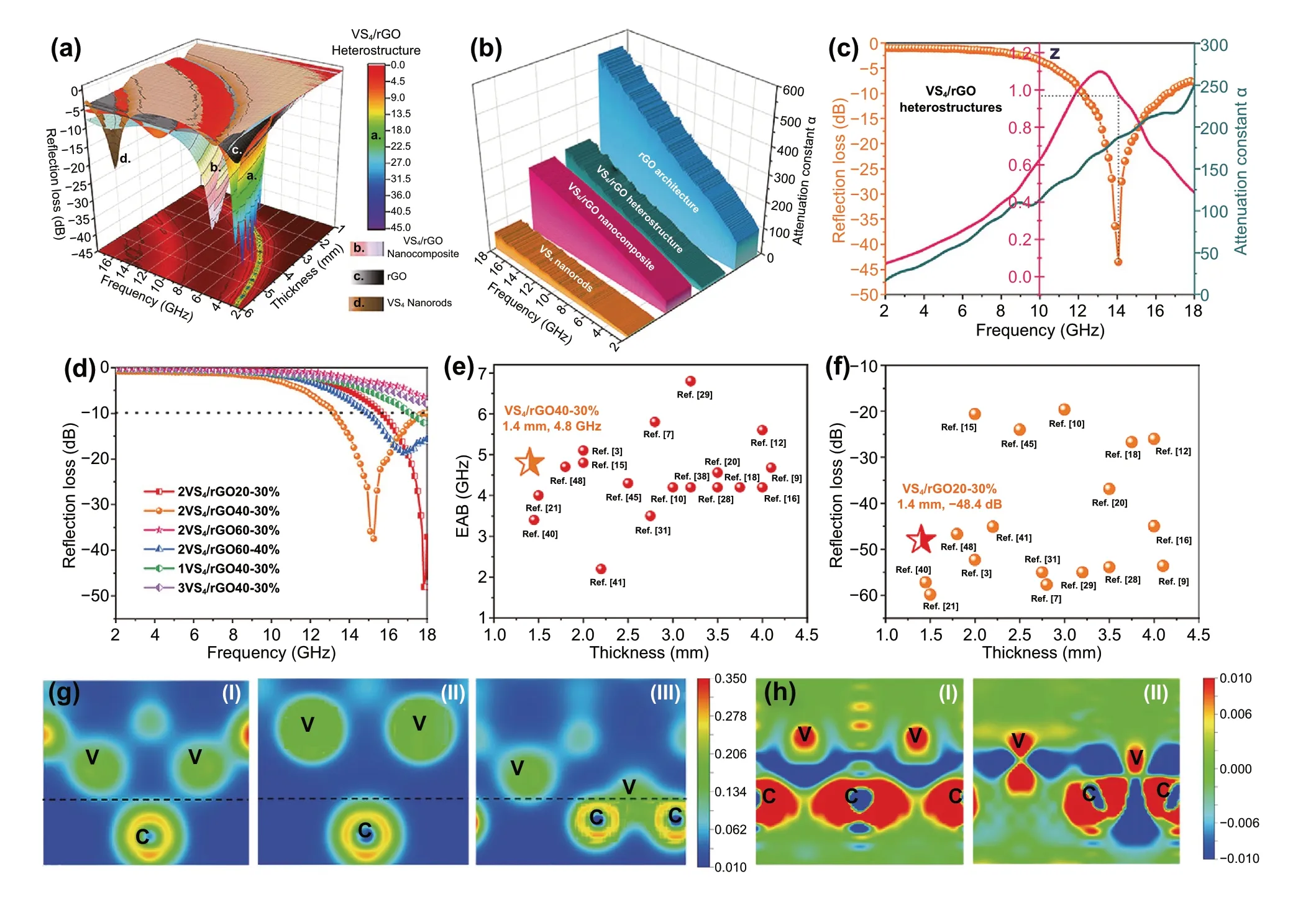
Fig.6 a 3D RL presentations of rGO,VS4 nanorods,VS4/rGO nanocomposite,and VS4/rGO heterostructure (2VS4/rGO40-30%).b Attenuation constant α of rGO,VS4 nanorods,VS4/rGO nanocomposite,and VS4/rGO heterostructures (2VS4/rGO40-30%).c Frequency dependence of RL,attenuation constant α and |Zin/Z0| at 1.5 mm for 2VS4/rGO40-30%.d RL of different VS4/rGO heterostructures at 1.4 mm.Comparison of some typical graphene-based absorbents for e EAB and f RLmax at different thickness.g Charge density of the interfaces (I) VS4(-2 0 4)/rGO (1 0 0)interface,(II) VS4(0 2 0)/rGO (1 0 0) interface,(III) V S4(1 1 0)/rGO (1 0 0) interface.h Charge density difference of (I) VS4(-2 0 4)/rGO (1 0 0)and (II) VS4(1 1 0)/rGO (1 0 0) interface
Except for the existence of heterointerface,the richness of heterointerface also exerts great influences on the microwave absorption performance.According to the above analysisof BET surface area and TGA results,the heterointerface and microarchitecture of VS4/rGO heterostructure can be modulated by the self-assembly generation of VS4nanorods anchored on rGO.Figure 6d shows the microwave absorption performance of different VS4/rGO heterostructures with a thickness of 1.4 mm in the frequency range of 2-18 GHz.2VS4/rGO40 with the optimal mass ratio of VS4and rGO as well as the largest BET surface area of 88.95 m2g-1possesses the EAB of 4.8 GHz with an ultrathin thickness of 1.4 mm.Without a doubt,the EABs of 1VS4/rGO40,3VS4/rGO40,2VS4/rGO20,and 2VS4/rGO60 are weaker than 2VS4/rGO40,which chiefly derives from their insufficient microarchitectures and heterointerfaces.The comparisons of microwave absorption performance between VS4/rGO heterostructure and other graphene-based absorbents are shown in Fig.6e-f as well as Table 1.As the consequence,the EAB and RL of VS4/rGO heterostructure outperform most of the graphene-based absorbents with a thickness of 1.4 mm.

Table 1 Typical graphene-based heterostructure and their microwave absorption performance
Comprehensive first-principles calculations are performed to probe the interfacial stabilities,interfacial bonding properties,and charge transfers at VS4/rGO heterointerface [44].Specifically,the selections of crystal structure models and calculation parameters are shown in Figs.S14 and S15. VS4can be grown on rGO along the (1 1 0) plane direction with the optimal lattice constant.The surface energy of VS4(1 1 0)/rGO (1 0 0) can be calculated to about 0.798 eV,which is lower than VS4(-2 0 4)/rGO (1 0 0) of 6.657 eV and VS4(0 2 0)/rGO (1 0 0) of 3.124 eV.Additionally,the V-terminated surface is more preferred to construct a heterointerface with rGO (1 0 0) than S-terminated surface (Fig S16).Therefore,the VS4/rGO heterointerface is prone to be bonded by V-C bands.As Fig.6g shown,VS4employs the (-2 0 4),(0 2 0),and (1 1 0) lattice planes to match the plane of rGO (1 0 0),respectively.Figure 6g(I) demonstrates the charge density of VS4(-2 0 4)/rGO (1 0 0) interface with an imaginary line on the heterointerface,and the C atoms above the heterointerface are far away from the bottom V atoms.Figure 6g(II)displays the charge density of VS4(0 2 0)/rGO (1 0 0) interface,and the distance of V and C atoms is farther than the VS4(-2 0 4)/rGO (1 0 0) interface.Therefore,V and C atoms are extremely difficult to bond together.Figure 6g(III)exhibits the charge density of VS4(1 1 0)/rGO (1 0 0) interface,and the shortest distance between V and C atoms is successfully realized.Due to the dislocation of the interface atom after relaxing,the V atoms are adjacent to C atoms with the formation of strong chemical bonds.Therefore,theVS4(1 1 0)/rGO (1 0 0) interface is easy to bond,and the result is consistent with the analysis of the above interface energy.Overall,the interfaces of VS4(-2 0 4)/rGO (1 0 0) and VS4(1 1 0)/rGO (1 0 0) have great potential to form chemical bonds [45].
The chemical bands further require to be analyzed by charge density difference of heterointerface.The charge density differences of VS4(-2 0 4)/rGO (1 0 0) and VS4(1 1 0)/rGO (1 0 0) heterointerfaces are shown in Fig.6h.Figure 6h(I) shows that the charges are increasing between V and C atoms significantly,proving the formation of the covalent bonds between V and C atoms.Figure 6h(II) displays that the charges are increased near C atoms obviously,while the charges are decreased near V atoms considerably,indicating part of the charges of V atoms is transferred to C atoms.So,the ionic bonds have formed between the V and C atoms.The calculated results of charge density difference exactly match the electronic binding energy shift measured by XPS,further proving the electrons migrate from the VS4to rGO (Fig.S6).Furthermore,the charge density difference in VS4/rGO heterointerface results in the enhancement of dipole and interfacial polarization relaxations,which greatly motivate microwave attenuation capability [46,47].
Based on the abovementioned analysis,the strategies of architecture design and interface engineering open a new door for the development of enhanced and ultrathin microwave absorbents.Figure 7 shows the schematic illustration of microwave absorption mechanism for VS4/rGO heterostructure.Architecture design and interface engineering inspire the synergy of multi-dimensional advantages,including the anisotropy of 1D nanorods,2D interface polarizations,and multiple microwave reflections or scatterings of 3D microarchitecture,facilitating to modulate impedance matching and attenuation constant[6,10].Firstly,1D V S4nanorods are anchored on rGO by van der Wall force and V-C bonds.The shape anisotropy and high aspect ratio of nanorods endow them with rapid charge transportation rate along the axial.The defects of VS4nanorods and residual oxygen-containing functional groups of rGO break the balance of charge distributions in nanorods and interface [11,26].Eventually,the induced multitudinous dipoles and interfacial polarization centers significantly facilitate polarization relaxations [39,48].Secondly,the constructed 2D VS4/rGO heterointerfaces are joined together firmly.Numerous randomly distributed space charges accumulated at the heterointerface generate prominent dipole moments and logs.Therefore,the fine connections of VS4/rGO heterointerface effectively modulate the impedance matching and greatly improve the interfacial polarization relaxation [41].Thirdly,the designed self-assembly 3D reticulum-like microporous VS4/rGO heterostructure provides a conductive paths for the electrons hopping and migrating between VS4nanorods and rGO.The foamed conductive networks remarkably prolong the transmission paths of microwaves,which encourage the transformation of EM energy into heat energy by the induced microcurrent in alternating EM fields [42,43].In summary,the mixed-dimensional advantages originating from the synergy of architecture design and interface engineering can boost an appropriate balance of impedance matching and attenuation constant,eventually achieving high-performance microwave absorption materials.
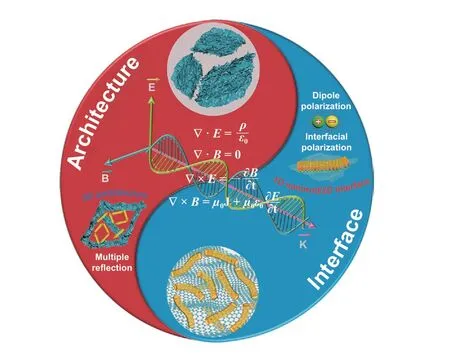
Fig.7 Schematic illustration for the microwave absorption mechanism of VS4/rGO heterostructure
4 Conclusions
In summary,the strategies of architecture design and interface engineering are proposed to construct the selfassembly VS4/rGO heterostructure for the ultrathin and enhanced microwave absorbent.The synergy of microarchitecture and heterointerface can effectively modulate the impedance matching and attenuation constant of VS4/rGO heterostructure,thereby achieving enhanced microwave absorption performance at ultrathin thickness.The maximum RL of 2VS4/rGO40 heterostructure can reach as strong as -43.5 dB at 14 GHz and 1.5 mm with the impedance matching and attenuation constant approaching 0.98 and 187,respectively.Furthermore,the EAB of 4.8 GHz can be achieved with an ultrathin thickness of 1.4 mm.DFT calculations provide a platform to decipher the interfacial polarization originating from heterointerface.Architecture design and interface engineering inspire multi-dimensional advantages,including anisotropic dipole polarization,interfacial polarization,and multiple reflections or scatterings of microwaves,eventually facilitating to achieve enhanced microwave absorption performance at ultrathin thickness.Therefore,architecture design and interface engineering offer an instructive attempt for the development of highperformance microwave absorption materials.
AcknowledgementsThis work was supported by the National Key Research and Development Program of China (Nos.2018YFA0703500),the National Natural Science Foundation of China (Nos.52188101,52102153,52072029,51991340,51991342,51972022),the Overseas Expertise Introduction Projects for Discipline Innovation (B14003),and the Fundamental Research Funds for Central Universities (FRF-TP-18-001C1).
FundingOpen access funding provided by Shanghai Jiao Tong University.
Open AccessThis article is licensed under a Creative Commons Attribution 4.0 International License,which permits use,sharing,adaptation,distribution and reproduction in any medium or format,as long as you give appropriate credit to the original author(s) and the source,provide a link to the Creative Commons licence,and indicate if changes were made.The images or other third party material in this article are included in the article’s Creative Commons licence,unless indicated otherwise in a credit line to the material.If material is not included in the article’s Creative Commons licence and your intended use is not permitted by statutory regulation or exceeds the permitted use,you will need to obtain permission directly from the copyright holder.To view a copy of this licence,visit http:// creat iveco mmons.org/ licen ses/ by/4.0/.
Supplementary InformationThe online version contains supplementary material available at https:// doi.org/ 10.1007/s40820-022-00809-5.
- Nano-Micro Letters的其它文章
- Correction to:Stable Zn Metal Anodes with Limited Zn?Doping in MgF2 Interphase for Fast and Uniformly Ionic Flux
- Surface Treatment of Inorganic CsPbI3 Nanocrystals with Guanidinium Iodide for Efficient Perovskite Light?Emitting Diodes with High Brightness
- State of the Art and Prospects in Metal?Organic Framework?Derived Microwave Absorption Materials
- High?Performance Blue Quasi?2D Perovskite Light?Emitting Diodes via Balanced Carrier Confinement and Transfer
- A Better Zn?Ion Storage Device:Recent Progress for Zn?Ion Hybrid Supercapacitors
- Ni Flower/MXene?Melamine Foam Derived 3D Magnetic/Conductive Networks for Ultra?Efficient Microwave Absorption and Infrared Stealth

